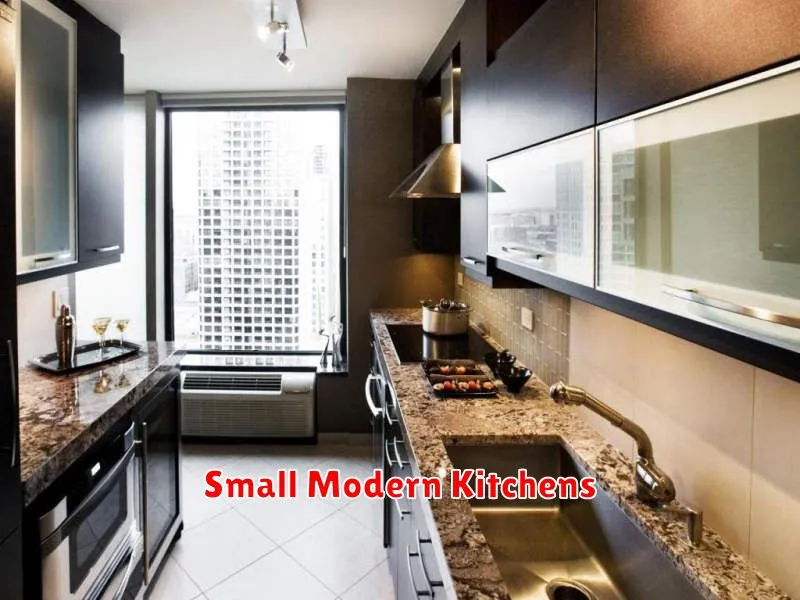Are you dreaming of a stylish and functional kitchen, but limited by a small space? Don’t despair! This article showcases 10 compact modern kitchen designs perfect for small homes. We’ll explore clever space-saving ideas, modern kitchen layouts, and compact kitchen designs that maximize storage and style without compromising on aesthetics. Get ready to be inspired by these small kitchen ideas that prove big style doesn’t require a big space! Discover how to create your dream modern compact kitchen, even in the smallest of homes.
L-Shaped Kitchen
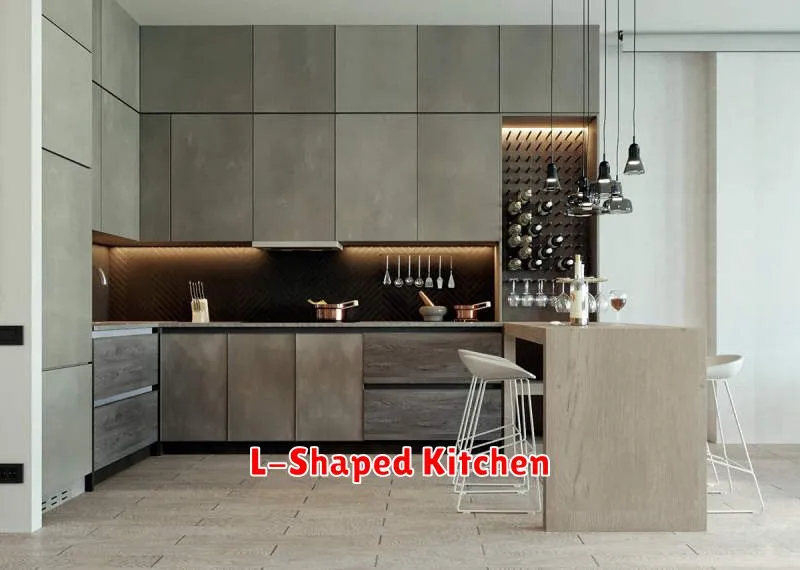
An L-shaped kitchen is a classic and popular layout choice for many homeowners. Its design, characterized by two walls of cabinetry meeting at a 90-degree angle, offers a fantastic blend of functionality and style. This layout is incredibly versatile and can work well in a variety of kitchen sizes, making it a great option for both small and large spaces.
One of the key advantages of an L-shaped kitchen is its efficient use of space. The layout naturally creates distinct zones for different kitchen activities. You can easily designate one area for food preparation, another for cooking, and a third for cleaning and dishwashing. This separation of tasks helps streamline your workflow and makes cooking a more enjoyable experience.
Storage is another significant benefit. The two walls of cabinetry provide ample space for storing cookware, dishes, appliances, and pantry items. With careful planning, you can maximize storage capacity by utilizing corner cabinets, drawers, and even pull-out shelves to ensure everything has its place.
The versatility of the L-shaped kitchen allows for customization to suit your specific needs and preferences. You can incorporate an island or peninsula for additional counter space and seating, making it ideal for entertaining. Adding a breakfast bar can also create a casual dining area, seamlessly integrating the kitchen into the overall living space.
However, there are some potential drawbacks to consider. In smaller kitchens, an L-shape might feel cramped if not properly planned. Careful consideration of appliance placement and traffic flow is essential to avoid bottlenecks and ensure a comfortable working environment. Also, depending on the size and layout of your kitchen, accessing certain areas might require more movement than in other kitchen designs.
Ultimately, an L-shaped kitchen is a practical and aesthetically pleasing choice for many homes. Its flexibility in design and efficient use of space make it a popular option for homeowners looking to create a functional and stylish heart of the home. With careful planning and consideration of your specific needs, an L-shaped kitchen can become the perfect culinary haven.
Galley Kitchen
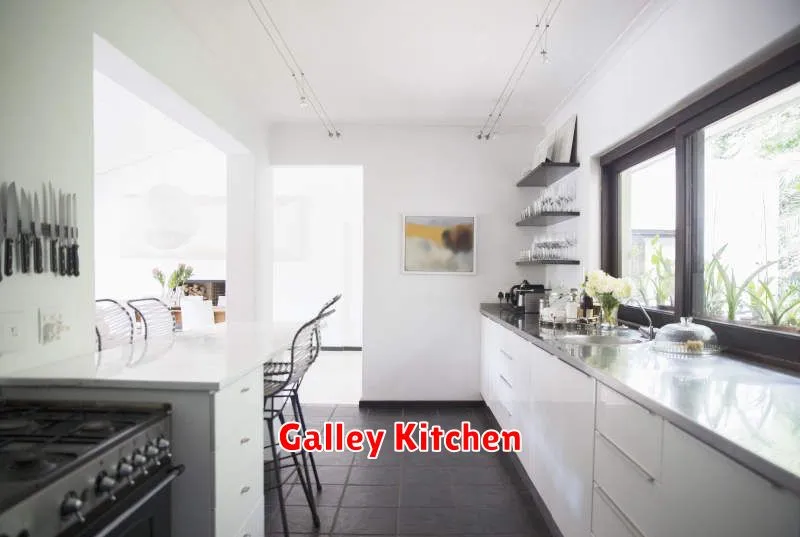
A galley kitchen is a long, narrow kitchen design, often found in boats, RVs, and smaller homes. Its efficient layout maximizes space by arranging cabinetry and appliances along two parallel walls, creating a corridor-like workspace. This design is perfect for those looking to optimize space without sacrificing functionality.
Key Features: Galley kitchens typically feature counter space on both sides, with appliances and storage strategically placed to minimize wasted steps. The linear layout promotes efficiency, making it easy to move between tasks. While compact, careful planning is crucial to ensure ample storage and workspace.
Advantages: The major advantage is space optimization. Ideal for smaller spaces, it maximizes every inch. The linear workflow can also be surprisingly efficient, encouraging a smooth and organized cooking process. Additionally, the streamlined design contributes to a clean and uncluttered aesthetic.
Disadvantages: The primary drawback is the limited counter and storage space compared to larger kitchen designs. Working in a galley kitchen can sometimes feel cramped, especially when multiple people are cooking simultaneously. Proper planning and careful selection of appliances are vital to avoid feeling confined.
Design Considerations: When designing a galley kitchen, consider the work triangle (sink, stove, refrigerator). Keeping these appliances close together improves efficiency. Opt for pull-out shelves and drawers to maximize storage in limited space. Light-colored cabinetry and good lighting can also help create a sense of spaciousness.
Modern Updates: While traditionally simple, modern galley kitchens can incorporate stylish features like sleek cabinetry, integrated appliances, and high-end countertops. Clever use of lighting and creative storage solutions can transform a small space into a highly functional and visually appealing kitchen.
In conclusion, the galley kitchen, despite its compact size, offers an efficient and stylish solution for smaller homes or spaces where maximizing functionality is key. With careful planning and creative design choices, a galley kitchen can be both beautiful and incredibly practical.
Open-Plan Kitchen
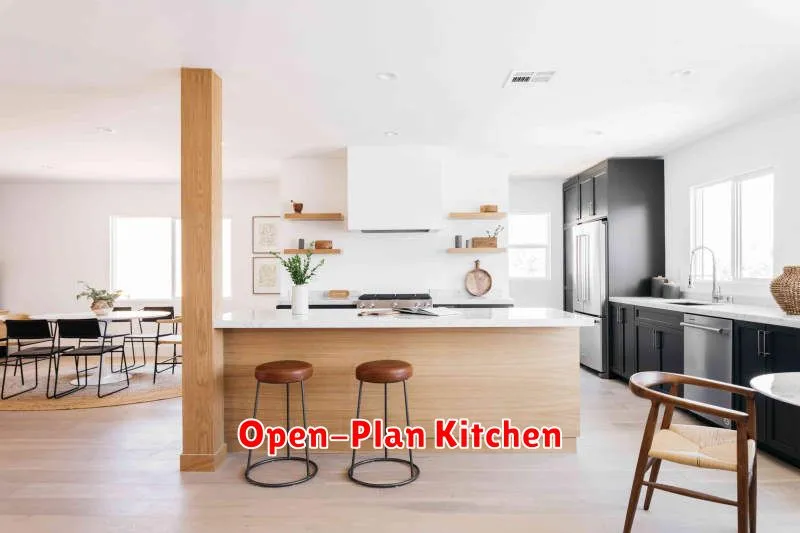
The open-plan kitchen has become a staple in modern home design, and for good reason. It offers a seamless flow between the kitchen and living spaces, creating a more inviting and sociable atmosphere. This design choice fosters interaction between family and guests, making meal preparation and entertaining a more shared experience.
One of the key benefits of an open-plan kitchen is the increased sense of space. By removing walls, you visually expand the area, making even smaller kitchens feel larger and brighter. This is particularly beneficial for homes with limited square footage. The open concept also allows for more natural light to permeate the entire area, creating a cheerful and airy ambiance.
However, there are also some considerations to keep in mind when designing an open-plan kitchen. Noise from appliances and cooking can easily carry into the living area, so soundproofing and careful appliance placement are important. Similarly, maintaining cleanliness can be more challenging, as any mess is immediately visible. Careful planning and consideration of storage solutions are essential to avoid a perpetually cluttered look.
Despite these potential drawbacks, the advantages of an open-plan kitchen often outweigh the challenges. The enhanced social interaction, increased sense of space, and improved natural light make it a popular choice for homeowners seeking a contemporary and functional living environment. Ultimately, the success of an open-plan kitchen hinges on careful planning and execution, taking into account the unique needs and lifestyle of the occupants.
Design elements such as a kitchen island, a breakfast bar, or strategically placed shelving can further enhance the functionality and aesthetic appeal of an open-plan kitchen. These additions not only provide extra counter space and storage but also create visual separation and definition within the open space, preventing it from feeling overwhelming.
In conclusion, the open-plan kitchen offers a compelling blend of style and functionality. While requiring careful planning and consideration, the resulting atmosphere of openness and sociability makes it a worthwhile investment for many homeowners.
Corner Unit Kitchen
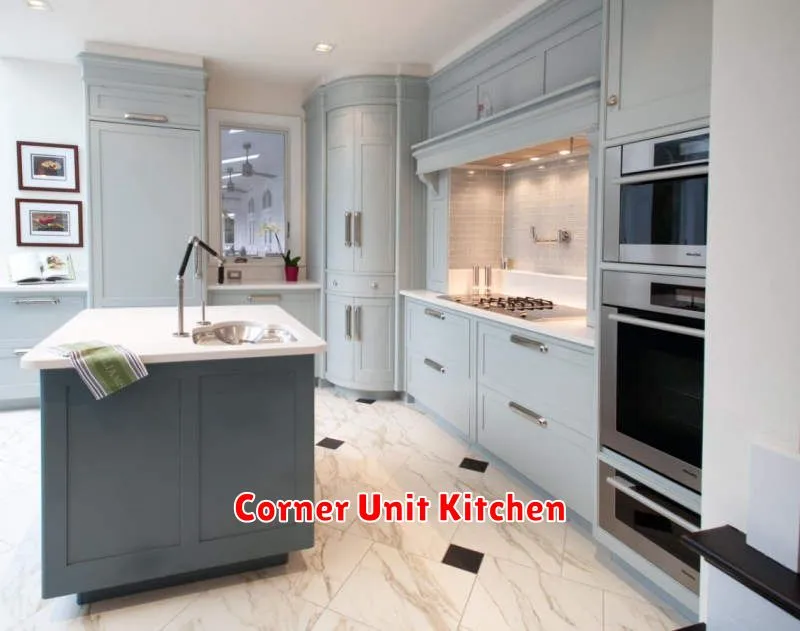
Designing a kitchen around a corner unit presents both challenges and exciting opportunities. A well-planned corner unit kitchen can be incredibly efficient and maximize space, but poor planning can lead to wasted space and awkward layouts. This guide will help you navigate the design process, ensuring your corner unit kitchen becomes the heart of your home.
Maximizing Space and Accessibility: The key to a successful corner unit kitchen is thoughtful consideration of storage and workflow. Clever use of corner cabinets is crucial. Avoid those frustrating “dead zones” often found in traditional corner cabinets by incorporating features like lazy Susans, magic corners, or pull-out shelves. These clever mechanisms make accessing items in the furthest corners simple and efficient. Think vertically too – utilize tall cabinets to their full potential to store less frequently used items.
Layout Considerations: The layout of your kitchen significantly impacts usability. Popular corner unit kitchen layouts include L-shaped and U-shaped designs. An L-shaped layout is ideal for smaller kitchens, efficiently using the corner to create a natural work triangle between the sink, stove, and refrigerator. A U-shaped layout is suitable for larger kitchens, offering ample counter space and storage. Remember to leave sufficient space for movement between appliances and countertops – approximately 36-48 inches is recommended for comfortable workflow.
Appliance Placement: Strategic placement of appliances is key. Consider the relationship between your cooking area, sink, and refrigerator. A good rule of thumb is to ensure these areas form a functional work triangle. Integrating appliances into your corner unit setup – such as a corner range hood or built-in microwave – can create a seamless and streamlined look.
Countertop and Cabinetry Choices: The materials you choose significantly impact both the aesthetic and functionality of your kitchen. Durable materials like granite, quartz, or laminate are popular for countertops, offering resistance to scratches and stains. For cabinetry, consider your style preferences and overall kitchen design. Choose materials that are both functional and visually appealing.
Lighting and Finishing Touches: Don’t forget the importance of adequate lighting. Task lighting under cabinets and pendant lights over islands or peninsulas provide practical illumination. Consider recessed lighting for overall kitchen brightness. Finishing touches such as stylish hardware, backsplashes, and flooring choices can elevate the overall look and feel of your corner unit kitchen.
Planning a corner unit kitchen requires careful consideration of several factors. By focusing on efficient storage, optimal layout, and thoughtful appliance placement, you can create a stylish and functional kitchen that will serve your needs for years to come. Remember to consult with a kitchen designer or contractor for personalized assistance in planning your dream space.
High Cabinets Kitchen
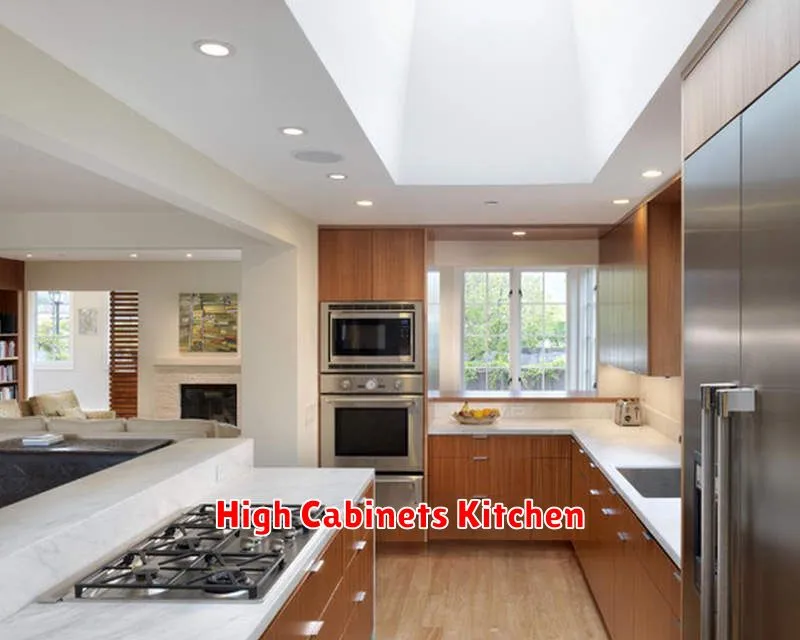
High cabinets are a fantastic way to maximize storage space in your kitchen, especially in smaller kitchens. They offer a vertical solution, allowing you to store items you don’t use frequently, freeing up valuable counter and lower cabinet space.
However, there are some important considerations before installing them. Accessibility is key. You’ll need a step stool or ladder to reach the upper shelves, which can be inconvenient for some. Therefore, planning what you store in the high cabinets is crucial. Items used less often, such as seasonal dishes or extra cookware, are ideal candidates.
The aesthetic impact of high cabinets shouldn’t be overlooked. They can create a sleek and modern look, particularly when paired with other contemporary features. However, in smaller kitchens, they might make the room feel even more cramped if not properly integrated into the design. Careful consideration of the cabinet style, color, and overall kitchen layout is necessary.
Installation is another factor to consider. High cabinets require professional installation, especially if you’re dealing with complex designs or unusual ceiling heights. This adds to the overall cost, which can be higher than standard cabinets. Also, remember to factor in the cost of specialized ladders or step stools for easy access.
Ultimately, deciding whether high cabinets are right for your kitchen depends on your individual needs and preferences. Weigh the benefits of increased storage against the potential drawbacks of accessibility and cost. Careful planning and professional advice will help you make an informed decision and create a functional and stylish kitchen.
Island Counter Kitchen
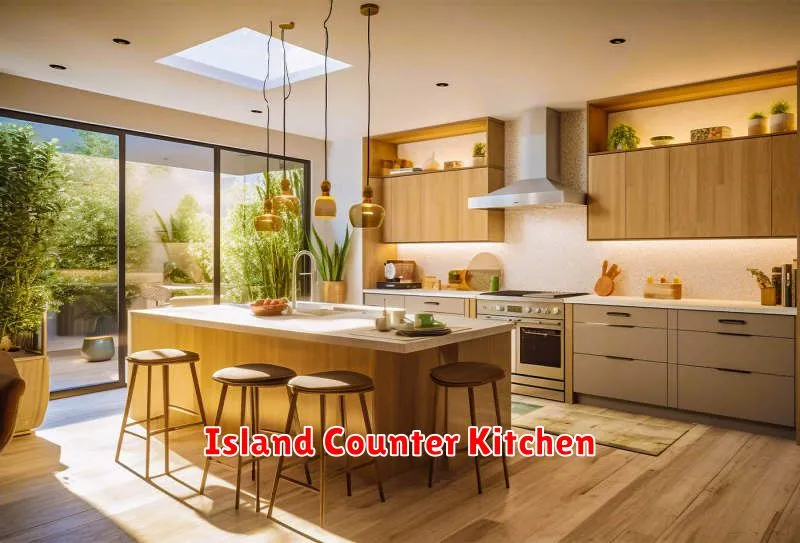
The island counter kitchen design has become incredibly popular in recent years, and for good reason. It offers a blend of style, functionality, and increased counter space that’s hard to beat.
One of the biggest advantages is the added workspace. An island provides a significant amount of extra counter area, perfect for food preparation, baking, or even a casual dining spot. This is especially beneficial for larger families or those who love to entertain.
Beyond practicality, the island adds a significant design element to your kitchen. It can be used to visually separate the kitchen from the dining or living area, creating distinct zones within your open-plan space. The style can be easily customized to complement your existing décor, whether it’s modern, rustic, or traditional.
Consider the size and layout of your kitchen carefully when planning an island. You’ll need sufficient space for comfortable movement around the island and to allow for easy access to other kitchen appliances and cabinets. A poorly planned island can actually hinder workflow.
Storage is another key consideration. Many island designs incorporate cabinets and drawers, providing valuable storage for cookware, utensils, and other kitchen essentials. This can help keep your countertops clutter-free and organized. Think about what you need to store and plan the island accordingly.
Finally, don’t forget the finishing touches. The countertop material, seating options (bar stools or chairs), and lighting can all contribute to the overall look and feel of your island counter kitchen. Choose materials and fixtures that reflect your personal style and complement your home’s aesthetic.
In conclusion, the island counter kitchen offers a compelling combination of style, functionality, and increased space. With careful planning and attention to detail, it can be a beautiful and practical addition to any home.
Dual-Tone Kitchen
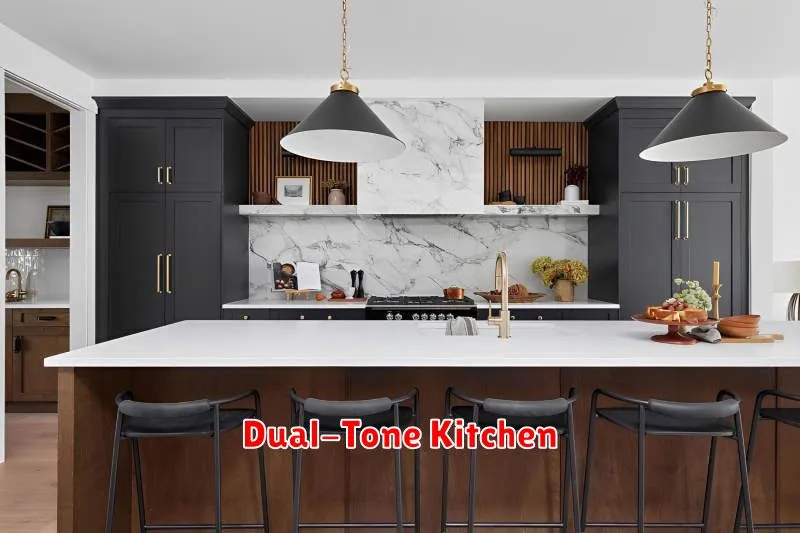
A dual-tone kitchen is a fantastic way to add personality and visual interest to your cooking space. It involves using two different colors on your cabinets, creating a dynamic and stylish look that can completely transform the feel of your kitchen.
The beauty of a dual-tone kitchen lies in its versatility. You can achieve a variety of aesthetics, from modern and minimalist to classic and traditional, simply by choosing the right color combinations. A dark lower cabinet with light upper cabinets, for example, creates a sophisticated and grounded look. Conversely, light lowers paired with dark uppers can make a small kitchen feel surprisingly spacious.
Choosing your color palette is key. Consider the overall style of your home and your personal preferences. Complementary colors, such as blue and orange, or green and purple, offer a bold and vibrant contrast. Analogous colors, which sit next to each other on the color wheel (like blues and greens), create a more harmonious and tranquil atmosphere. Don’t be afraid to experiment with different shades and tones to find the perfect balance.
Beyond color, think about the materials you choose. A combination of matte and glossy finishes can add texture and depth. For instance, pairing matte gray lower cabinets with glossy white uppers creates a luxurious and modern feel. The hardware you select also plays a significant role; consider brushed nickel, polished chrome, or even black hardware to complement your chosen color scheme and overall style.
Ultimately, a dual-tone kitchen allows for a high degree of customization. Whether you’re aiming for a sleek, contemporary look or a warm, inviting space, the possibilities are truly endless. It’s a design choice that provides both style and functionality, enhancing the heart of your home.
Modern Rustic Kitchen
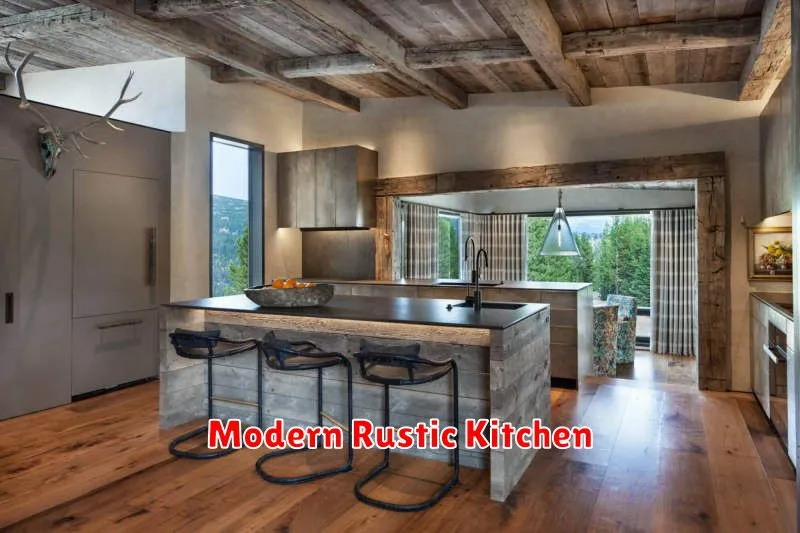
A modern rustic kitchen blends the best of both worlds: the clean lines and sleek functionality of modern design with the warmth and charm of rustic elements. This style offers a unique and inviting space that is both stylish and practical. It’s a popular choice for homeowners who want a kitchen that feels both contemporary and comfortable.
Key Elements of a modern rustic kitchen often include natural materials like wood, stone, and metal. Think reclaimed wood beams on the ceiling, a large farmhouse sink made of stone, and sleek stainless steel appliances. These materials create a sense of authenticity and groundedness, contrasting beautifully with the clean lines and minimalist aesthetic of the modern design.
Color palettes typically feature a mix of neutral tones with pops of color. Earthy hues like beige, gray, and brown are common, complemented by accents of deeper colors such as navy blue, forest green, or warm terracotta. This creates a balanced and sophisticated look that avoids being too stark or too cluttered.
Lighting is crucial in a modern rustic kitchen. A combination of ambient, task, and accent lighting is ideal. Recessed lighting can provide general illumination, while pendant lights above the island or bar add a touch of rustic charm. Strategically placed spotlights can highlight specific features, such as a beautiful stone backsplash or a unique piece of artwork.
Appliances should be chosen carefully to maintain the balance of styles. While sleek stainless steel appliances are a common choice, consider options with a more matte finish or integrated designs to avoid a jarring contrast with the rustic elements. The goal is to seamlessly integrate the modern technology with the overall design aesthetic.
Cabinetry is another key design element. While traditional shaker-style cabinets are a popular choice, consider incorporating unique materials such as reclaimed wood or painted wood with a distressed finish. Open shelving can also be used to display beautiful dishes and cookware, adding to the rustic feel.
Ultimately, a successful modern rustic kitchen is a carefully curated blend of contrasting styles. The key is to strike the right balance between the clean lines of modern design and the warmth and texture of rustic elements, resulting in a kitchen that is both beautiful and functional, reflecting your personal style and providing a space you’ll love to spend time in.
Monochrome Kitchen
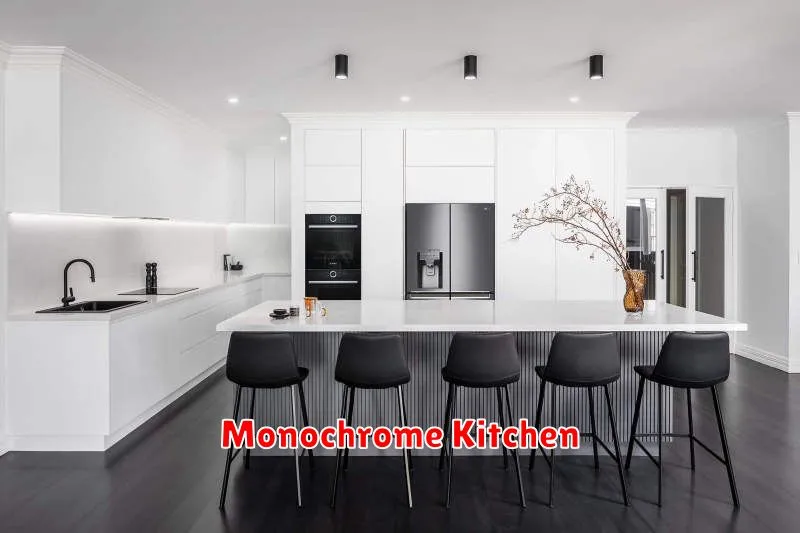
A monochrome kitchen is more than just a design trend; it’s a statement. It’s about embracing simplicity, elegance, and a sophisticated level of design. By focusing on a single color family, you create a space that is both calming and incredibly stylish. The key is to play with texture and shades to prevent the space from feeling flat or monotonous.
Choosing your color is the first crucial step. Popular choices include various shades of white, gray, or black. White kitchens offer a bright, airy feel, perfect for smaller spaces. Gray provides a more sophisticated and modern aesthetic. Black kitchens, while dramatic, are incredibly chic and undeniably stylish – ideal for those who want a bold statement.
Once you’ve selected your base color, consider how to introduce variety through texture. Think about different materials: a sleek marble countertop alongside matte cabinetry, or a wooden island contrasting against a smooth, painted wall. This layering of textures keeps the design interesting and prevents visual fatigue.
Lighting is key in a monochrome kitchen. Ensure you have a combination of ambient, task, and accent lighting to highlight the textures and add depth. Recessed lighting provides even illumination, while pendant lights over the island can serve as both functional and stylish focal points. Consider strategically placed under-cabinet lighting to highlight countertops and backsplashes.
Accessorizing is where you can add a touch of personality without disrupting the overall monochrome theme. Metallic accents, such as gold or copper hardware, can add warmth and visual interest. Subtle pops of color in carefully chosen accessories, like a patterned rug or a statement vase, can add a personalized touch without overpowering the design.
Ultimately, a monochrome kitchen is a testament to the power of simplicity and sophistication. By carefully considering color, texture, and lighting, you can create a space that is both stylish and functional, a haven of calm amidst the everyday bustle.
Compact Modular Kitchen
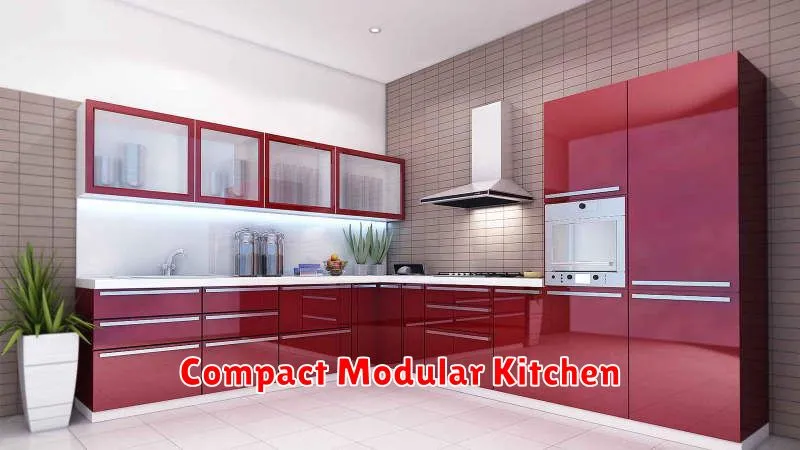
Designing a compact modular kitchen can be a fun and rewarding experience, especially for those living in smaller spaces. It allows you to maximize functionality and style without sacrificing precious square footage. With careful planning and the right choices, you can create a kitchen that is both beautiful and highly efficient.
One of the key advantages of a modular kitchen system is its flexibility. Units can be arranged to suit your specific needs and the layout of your space. Whether you have a galley kitchen, an L-shaped kitchen, or a small, open-plan area, modular components allow for customization. Consider incorporating clever storage solutions such as pull-out drawers, corner units, and vertical shelving to optimize every inch of space.
Space-saving appliances are crucial in a compact kitchen. Look for slimline dishwashers, compact refrigerators, and microwaves that combine multiple functions. A multi-functional oven can free up valuable counter space. Choose appliances that fit seamlessly into the design and don’t overwhelm the small space.
The choice of color scheme plays a vital role in creating an illusion of spaciousness. Light and bright colors like white, cream, or pastel shades reflect light, making the kitchen appear larger. You can add pops of color with accessories or patterned backsplashes to prevent the kitchen from looking sterile. Clever lighting is also key – consider under-cabinet lighting or pendant lights to brighten up darker corners.
Careful material selection is also important. Opt for lightweight materials like acrylic or laminate for the cabinetry to reduce the visual weight of the units. Choose countertops that are durable and easy to maintain. Consider using reflective surfaces to add depth and brightness to the compact space.
Remember, the design of your compact modular kitchen should reflect your personal style. While functionality is important, don’t compromise on aesthetic appeal. With careful planning and the right choices, you can create a stunning and highly functional kitchen, even in a limited space.

